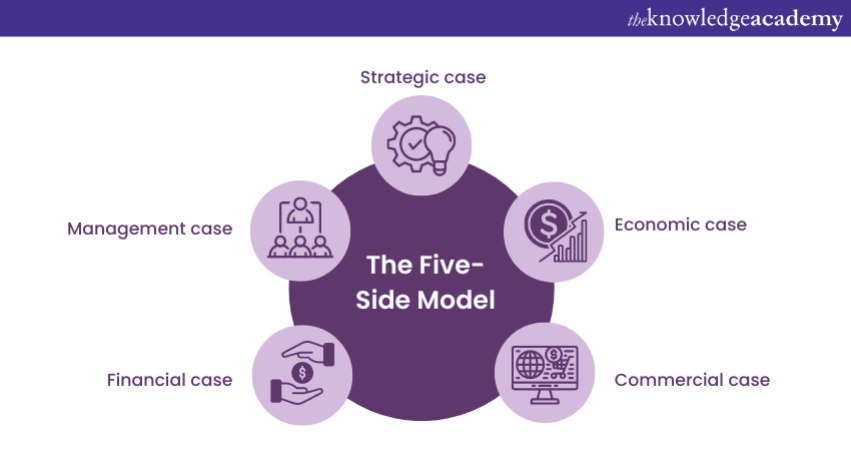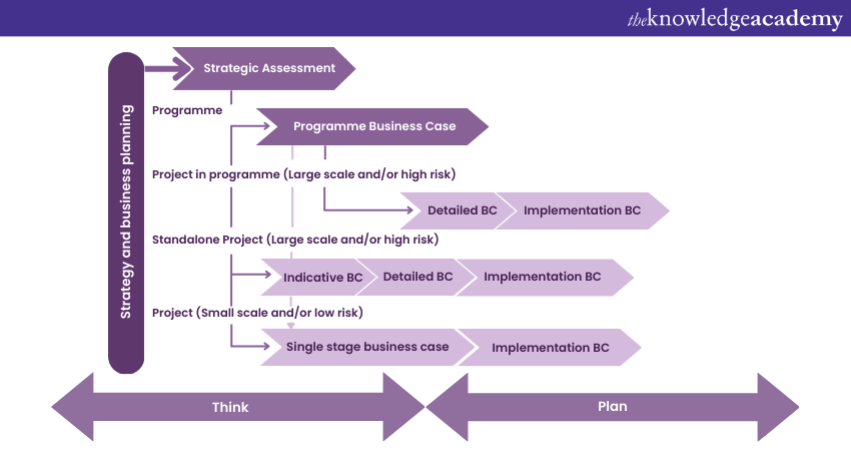We may not have the course you’re looking for. If you enquire or give us a call on +0800 780004 and speak to our training experts, we may still be able to help with your training requirements.
Training Outcomes Within Your Budget!
We ensure quality, budget-alignment, and timely delivery by our expert instructors.

The advent of digital technology in organisations has revolutionised our general idea of the workplace. With more and more technologies surfacing every year, we are straying further and further away from the traditional working process of an organisation. Therefore, to keep up with the competition and maintain its place in the market, an organisation needs to adapt to the latest technological developments. One of the many instances of digital transformation adopted by governments is the Better Business Cases (BBC) guidance.
According to a 2018 report by the UK Treasury, over 3,000 people had completed BBC training, and more than 500 business cases had been assessed using the approach. This shows the increasing prevalence of Better Business Cases in the modern workplace in the United Kingdom. This blog will elaborate on what Better Business Cases (BBC) is, how to get started with it, and its structure.
Table of Contents
1) What is Better Business Cases?
2) How to get started with Better Business Cases?
3) The structure of Better Business Cases
a) The five-case model
b) Approval Processes
3) How to complete the five cases?
a) Strategic case
b) Economic case
c) Commercial case
d) Financial case
e) Management case
4) What are the courses offered by Better Business Cases?
a) Better Business Cases Foundation
b) Better Business Cases Practitioner
5) Conclusion
What is Better Business Cases?
The Better Business Cases (BBC) guidance is a structured approach to developing business cases for public spending proposals used in the United Kingdom. It summarises the Better Business Cases framework, demonstrates where you can get support and training, and shows how to set up projects to maximise value. According to the UK government’s guidance on BBC, the approach is mandatory for all central government departments and their adjacent bodies, as well as for local authorities seeking funding from the central government.
Better Business Cases (BBC) was developed in association with the United Kingdom Treasury and has since been adopted in the European Union for infrastructure projects. The goal of BBC is to help governments make smart investment decisions that look to get the most public value. The BBC training and certification is structured on the “Five-Case Model”, the United Kingdom government’s state-of-the-art practice approach to the development of spending proposals and enabling effective business decisions.
BBC provides objective analysis to decision-makers, enabling smart and informed investment decisions that create the most public value. It also facilitates transparency and comparability in project creation. The better business case approach to spending proposals and business decisions involves:
1) Establishing a comprehensive need for intervention
2) Establishing clear goals and objectives
3) Considering a wide variety of potential solutions
4) Arranging methods and putting them in place to successfully deliver the proposal
Want to strengthen your Better Business Cases foundation? Join our Better Business Cases Foundation course!
The structure of Better Business Cases
The Better Business Cases guidance splits the business cases into two different parts – The Five-Case Model and Approval Processes. We’ll discuss both in detail:
The Five-Case Model

The Five-case Model has been the established standard for government business cases in the United Kingdom since the early 2000s. In 2018, the G20 adopted it as the global standard for infrastructure projects.
At its core, the Better Business Cases framework answers five key questions, and is divided into five parts:
1) Strategic case
2) Economic case
3) Commercial case
4) Financial case
5) Management case
Approval processes
Some business cases need a two-stage approval while others need just one.
1) Two-stage approvals: The Cabinet-mandated two-stage approval process is followed by high-risk and large-scale projects. One must get his business case approved in two stages.
a) Indicative Business Case: Also known as a Programme Business Case (PBC), it refers to a high-level analysis of the preferred way forward (a shortlist of options) as well as a plan for how one will assess the shortlist and the marketplace.
b) Detailed Business Case: It refers to the preferred option from the aforementioned shortlist, as well as the plan to implement and obtain it.
c) While the Indicative Business case focuses most on the Strategic case, it will focus less on the Economic and Financial cases – and even less on the Commercial and Management cases.
2) Single-stage approvals: The single-stage business case is used by lower-risk and lower-cost projects. The single-stage business case combines the Indicative and Detailed Business Cases and does not go into as much detail as the two-stage approval process does.
3) Implementation business case: Both the single-stage and two-stage approval processes have an additional stage. The Implementation business case is used to get a sign-off on your preferred supplier and planned contracts. This business case also reflects any changes that have come out of any previous approval processes.
4) Programme and project approvals at a glance: The graphic below sums up the planning and approval process for different programmes and projects.

Understand the fundamentals and key concepts of business care development by signing up for our Better Business Cases Practitioner course.
How to complete the five cases?
This section of the blog provides you with a detailed summary of what each case from the five-case model covers.
Strategic case
The Strategic Case of the five-case model explains the benefits of business case that the project will deliver and how they align with the organisation's strategy. These benefits should be SMART: specific, measurable, achievable, relevant, and time-bound. In the Strategic Case, you cover:
1) The Strategic Context:
a) Organisational Overview
b) Alignment to Strategic Intentions
The Case for Change:
a) Investment Objectives
b) Potential scope and services
c) Main benefits
d) Main risks
e) Key Constraints, dependencies, and assumptions.
The purpose of the Strategic dimension is to demonstrate how the proposed initiative is a strategic fit and make an appeal for change. Updating the organisational strategy that references all relevant policies can help show that the proposed initiative is a holistic fit with other projects and programs.
Challenges of the Strategic Case include explaining how intervention will deliver output and ensuring that the organisation's proposals focus on business needs supported by demand and capacity planning. Additionally, ensuring that initiatives are planned and delivered as part of an organisational strategy is another challenge.
Economic case
The Economic Case of the five-case model assesses options to determine the one that will deliver the highest public value through a cost-benefit analysis
These options include:
1) The status quo (“do nothing new”)
2) An achievable minimum option that meets only the essential requirements
3) The preferred way forward
In the Economic case of the five-case model, one will cover:
1) Critical success factors
2) The preferred way forward
3) Long-list options
4) The short-list options and assessment of options
5) Economic assessment of the short-list options
6) Testing the robustness of the options analysis
7) Risk and uncertainty
8) Non-monetary benefits and costs
9) Preferred option
The purpose of the Economic dimension is to identify the proposal that provides the maximum public value, including social and environmental effects. Realistic options need to be assessed, and a reduced number of possible options must be evaluated in detail.
The challenges for the Economic case are selecting the right options, justifying higher cost options, measuring and/or monetizing benefits and risks, and identifying trades between cost and non-monetisable value.
Commercial case
The Commercial Case of the five-case model demonstrates how the procurement process will work for both the agency and the suppliers, as well as how it is feasible in the relevant marketplace. In the Commercial case of the five-case model, one covers:
1) Procurement strategy
2) Risk allocation
3) Contractual agreements
4) Required services and outputs
5) Payment mechanisms
6) Accountancy treatment
7) Personnel implications
8) Evaluation of best and final offers
9) Confirmation of Commissioner’s support
10) The negotiated deal and contractual arrangements
The Commercial dimension of the business case aims to demonstrate that the preferred option will result in a feasible procurement and a well-structured deal with the public sector and its service providers. To show a viable procurement, one needs to understand the marketplace and knowledge of the supply side’s realistic potential achievements. One also needs a well-researched procurement route that will deliver the best value to both parties.
The challenge for the Commercial dimension is to anticipate from the outset how the optimal public value can continue to be secured during the contract phase, during a phase of change to business, organisational, and operational needs.
Financial case
In the Financial case of the five-case model, it is demonstrated that the project is affordable and that the funding for the whole project is secured. In the Financial case of the five-case model, one will cover:
1) Financial costing model
2) Financial implications of the deal
3) Impact on the balance sheet
4) Overall affordability and funding
5) Capex and Opex requirements
6) Confirmation of support
The Financial dimension of the business case aims to show the affordability and fundability of the preferred option, including stakeholders and customer support as necessary. To demonstrate the affordability and fundability of the preferred option, one requires a complete understanding of the capital, revenue, and whole-life costs of the proposed initiative. One also needs to have a clear picture of how the deal will impact the balance sheet, income, expenditure, and pricing arrangements of the organisation.
The challenge of the Financial dimension is to identify and resolve any funding gaps that may rise during the lifespan of the proposed initiative.
Management case
The final case of the five-case model is known as the Management case. The Management case shows how one will deliver, monitor, and evaluate the project. In the Management case of the five-case model, one will cover:
1) Programme management governance (in case of a programme and not a project)
2) Project management
3) Change management
4) Benefits management
5) Assurance and risk management
6) Contract management
7) Post-project evaluation
The challenges that the Management case faces are to manage risks in the design, building, funding, and operational phases of the initiative and put contingency plans in place. The Management phase also deals with inevitable changes in business and service delivery in a controlled environment, and ensures that the objectives are fulfilled, outcomes are delivered, and benefits are evaluated.
What are the courses offered by Better Business Cases?
Better Business Cases program offers two courses: the Better Business Cases Foundation, and Practitioner courses.
Better Business Cases Foundation
The Better Business Cases Foundation offers a comprehensive and detailed introduction on how to develop a business case using the Five Case Model. Through advice on the best practices, loopholes to avoid, mock exam questions, instances and case studies, one can gain:
1) Valuable insight into how to develop an effective business case with public value at its core
2) The knowledge of how to plan investment decisions better
3) The skill of developing a concrete framework for transparent decision-making
4) A globally recognised qualification as per relevant standards
Better Business Cases Practitioner
The Better Business Cases Practitioner course is meant to validate that you have an adequate understanding of the theory and application of the Five Case Model – which will help you lead the production of a Better Business Case. Certification in the Practitioner course helps one gain:
1) A practical understanding of the construction of a business case using the Five Case Model
2) Validation that the approach one uses is a tried and tested methodology
3) The ability to report effectively to the concerned decision-makers to help achieve the best value for money
4) A globally recognised qualification in business case development
Conclusion
All in all, the Better Business Case guidance is a structured approach to developing business cases for public spending proposals used in the United Kingdom. It is used within the UK Government and provides guidance on how to set up projects to maximise public value. The Better Business Cases guidance splits the business cases into two different parts, the Five-Case Model and the Approval processes. Hope this blog gave you the insights you needed into the working processes of both the BBC guidance components!
Learn how to develop a comprehensive business case by signing up for our Better Business Cases training.
Frequently Asked Questions
Upcoming Project Management Resources Batches & Dates
Date
 Better Business Cases™ Foundation & Practitioner
Better Business Cases™ Foundation & Practitioner
Thu 1st Jan 1970







 Top Rated Course
Top Rated Course



 If you wish to make any changes to your course, please
If you wish to make any changes to your course, please


